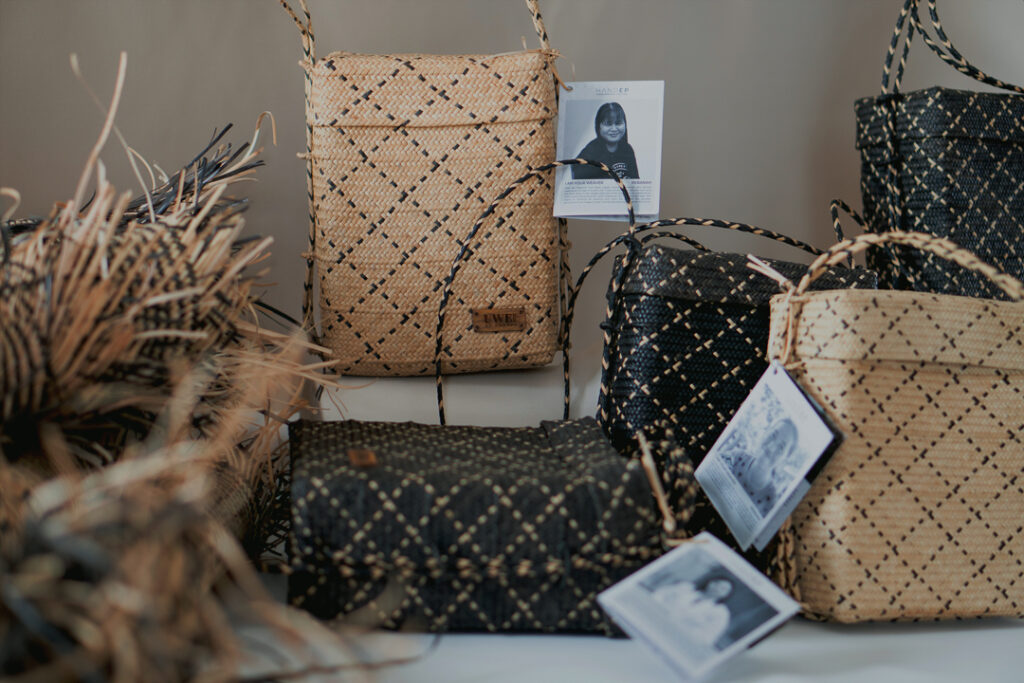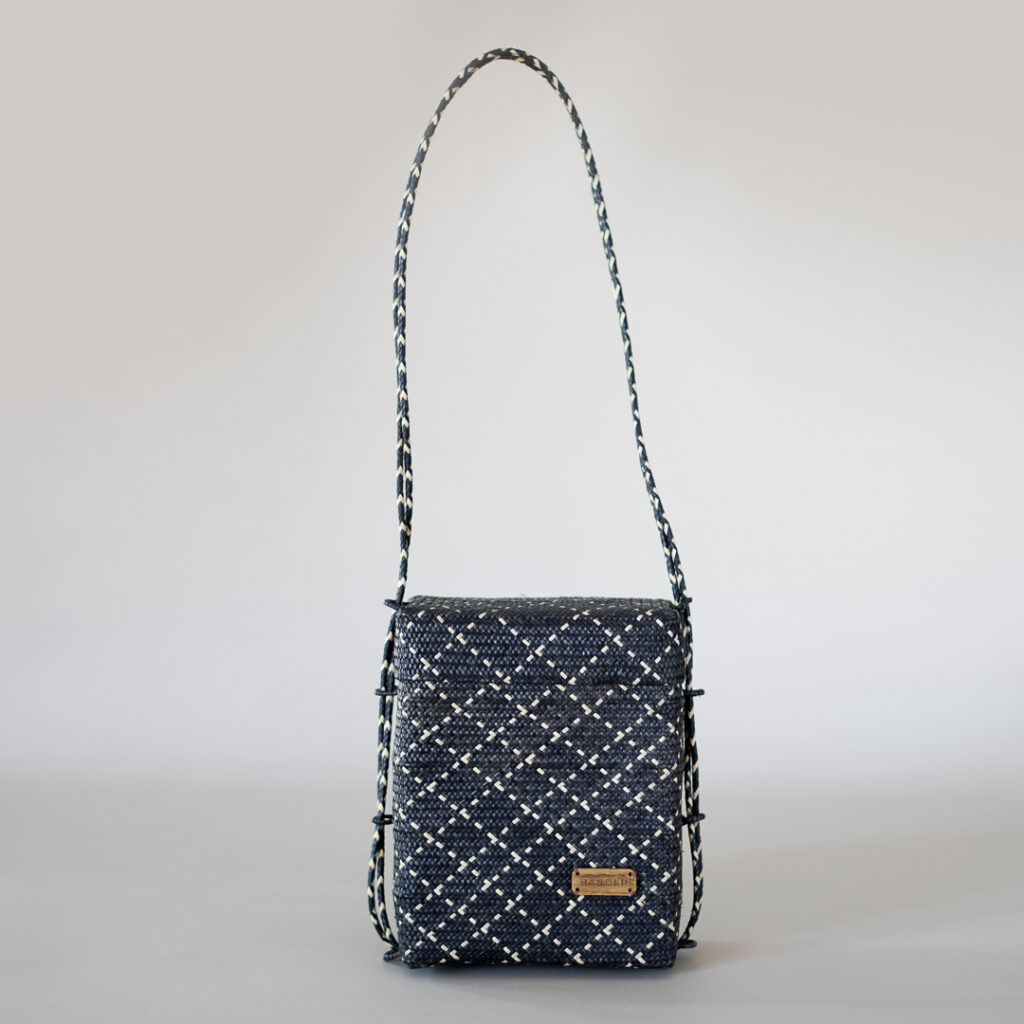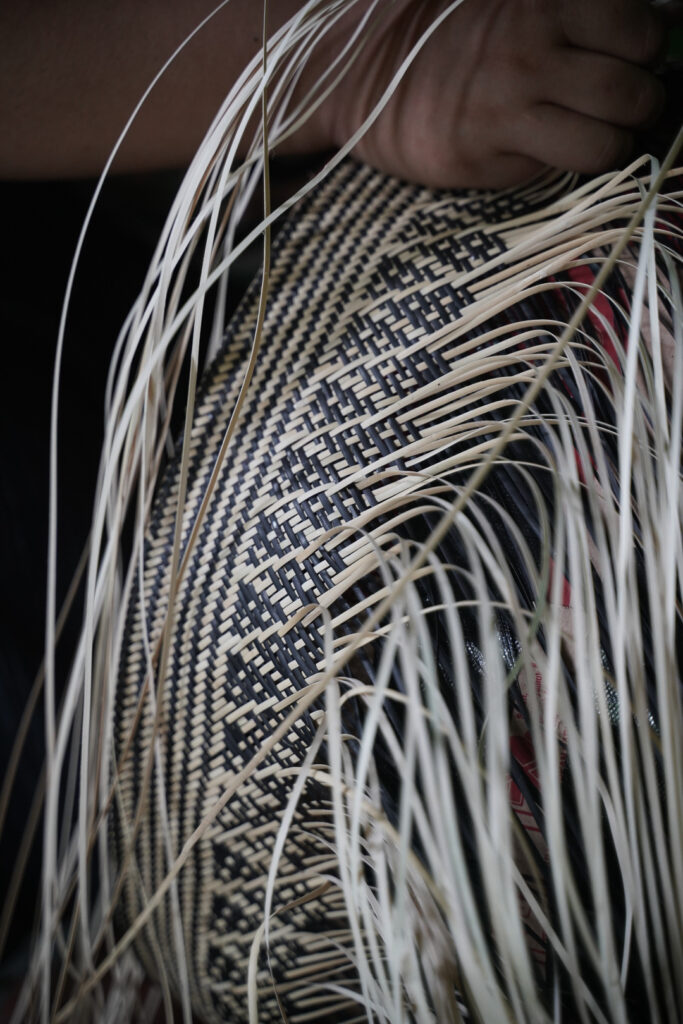
Bahari Bag in Delupang Cream and Delupang Black, rattan, dimensions (17cm x 8,5cm x 15,5cm); photo: HANDEP
Atri Priyamanaya from HANDEP tells how they drew on the unique fibre weaving knowledge of a Dayak elder to revive the beautiful basketry techniques of Central Kalimantan, resulting in a stylish bag.
Deep in Central Kalimantan, indigenous Dayak communities thrive in harmony with the forests that have provided them shelter, food, and livelihood for generations. The richness of their lands is a cacophony of experience for the senses; deep hues of greens decorate their backyards, towering trees, and bushy undergrowth shower them with scents, and diverse textures that require their touch to navigate when sight only reveals a portion of the information available.
It’s no wonder that the nature that is so prevalent around them becomes a part of their standards of beauty, seeping into the lives inside their homes through items that capture moments, crafted as motifs on handwoven rattan bags, baskets, mats, and wall coverings.
Weaving is a way for the Dayak people to tell their stories and to preserve images of their homes. It often represents spiritual connections and beliefs. But it’s an artform that is being left behind by its people. Seen as a time-intensive activity to create hand-made items that can be bought at a much cheaper price in plastic form, weaving is rapidly losing popularity and the expert hands that mastered traditional techniques are losing their touch.
Rediscovering History
- Itak (Grandma) Sein; photo: HANDEP
- Itak (Grandma) Sein,; photo: HANDEP
- Itak (Grandma) Sein with the Bahari Bag in Delupang Cream; photo: HANDEP
Concerned about the rapidly disappearing culture they grew up with, Dayak youths with an interest in cultural preservation converged in HANDEP, a social enterprise whose name is borrowed from the Dayak Ngaju dialect that means “the spirit of working together”. Randi Julian Miranda, its CEO and founder, seeks to elevate Dayak traditional craft while balancing the importance of fulfilling the Dayak people’s need to grow and flourish in the modern world.
“We work with indigenous artisans who are keeping the craft alive, traditional Dayak weaving is a living piece of history that we are still learning about,” he says. In a small village in North Barito, Central Kalimantan, Randi and his team met Itak (Grandma) Sein, who weaved the paths for her five children to receive higher education through her work in creating traditional Dayak rattan bags. Well-known and respected in her village for her skills, Itak Sein introduced the team to a rectangular bag that immediately caught their attention.
“In the five villages we regularly visit and the hundreds of Dayak weavers that we spoke to, Itak Sein was the only person who could weave tight corners to create a rectangular base,” he said. Using a mould as a base to weave from the bottom to the top, she manipulates the rattan strands into a bag that doesn’t use any additional frames to keep its shape. “This was a technique that no one else had in their repertoire. We knew that this discovery could get other artisans excited about weaving, and could be the key to shine a light on how special Dayak weaving can be,”
With Itak Sein having just turned 83 years old, the HANDEP team knew they were racing against time to make sure that enough of the younger generation could learn directly from the master. They crowdfunded a program that allowed Itak Sein and eleven apprentices to devote their time fully to knowledge transfer sessions. Itak Sein’s master class in weaving went on for several weeks, her patient hands slowly guiding her apprentices to feel out each individual strand. To identify how they can be combined with a similar strand to create rounded pairs that give a smoother, softer look that is both delicate and sturdy. Not only did the apprentices discover new ways of handling rattan, but they also reconnected to a part of their history that was being forgotten.
“The bag was originally made to carry Sipa (a mixture of betel leaves and areca nuts that are used for chewing habits, similar to tobacco chewing) and other necessities, through varied terrains and activities. It had to be reliable. This is a bag that was created out of necessity, not based on fleeting trends or looks alone. But it’s human nature to want something that has an aesthetic value—that’s where the colours and patterns come into play,” Randi said.
Each session, the younger weavers came to Itak Sein with their own attempts at creating the now-named Bahari Bag, with its irregular criss-cross pattern that gives the bag an organic accent, all in various stages; strands sticking out, patterns clumsily constructed, misshapen corners, and a multitude of other issues they had yet figured out. Weaving is as much about understanding the technique as it is about practiced hands. The only way to really pick up the skill was to repeat the process until their fingers learned a whole new choreography of movement. When to be rigid to give extra support, and when to be flexible so they can easily twist the strands into specific shapes.
Even though the eleven apprentices have been declared graduates of Itak Sein’s class, they are still learning about the process with each new Bahari Bag they make, muscle memory slowly forming day by day. Weaving history is hard work, and the weight of the generations of Dayak women before them lay on the tips of their fingers every time they sit down together, ready to weave and chat after a long day’s work in the forests and fields of Central Kalimantan.
Keeping Craft Alive
- Artisan weaving traditional Dayak pattern; photo: HANDEP
- Artisan weaving traditional Dayak pattern; photo: HANDEP
- Artisan weaving traditional Dayak pattern, ; photo: HANDEP
For many of the HANDEP team, preserving the weaving culture they grew up with was a major motivation, but more than that, they wanted to breathe life into it. Keeping it relevant in the lives of its consumers is one thing, but to bring excitement to the indigenous communities who are the artisans, and to encourage them to see it as more than just a throwaway commodity is another.
Reigniting the pride that the craft deserves is a complicated issue with ties to financial freedom, personal achievements, and the possibility for growth. “One of the struggles we’ve faced is in convincing our artisans that their craftsmanship sits on a stage of its own. That people seek out their specific creations, and that they consider the rattan bags as something that is unique and worthy of praise,” Randi explained.
An age-old tradition passed down through generations through direct practice, weaving isn’t seen as a particularly special skill. Most Dayak women learn to weave as soon as they learn how to play, sitting with their mothers and grandmothers as early as six years old, figuring out how much force can be used to bend rattan until it loses its functionality, how thin they can strip the strands until it becomes unusable as weaving material and becomes more suitable for a binding string. Their hands become well-honed instruments that turn unyielding sticks of rattan into bags that are as flexible as canvas and last as long as leather craft.
Like the rattan they use that thrives best in balanced forest settings, traditional Dayak artisans grow and flourish best in their native lands. From hand to hand, passing down ancestral knowledge through touch, feel, and stories; connecting communities and growing the personal pride of the artisans and connecting them to a global market is an ongoing effort that seeks to not only keep the craft alive, but also to flourish. Creating a space of its own with their deft hands.

Itak (Grandma) Sein, Bahari Bag in Delupang Black, rattan, dimensions (17cm x 8,5cm x 15,5cm); photo: HANDEP
Visit handep.co/, follow handepharuei and like handepshop.







